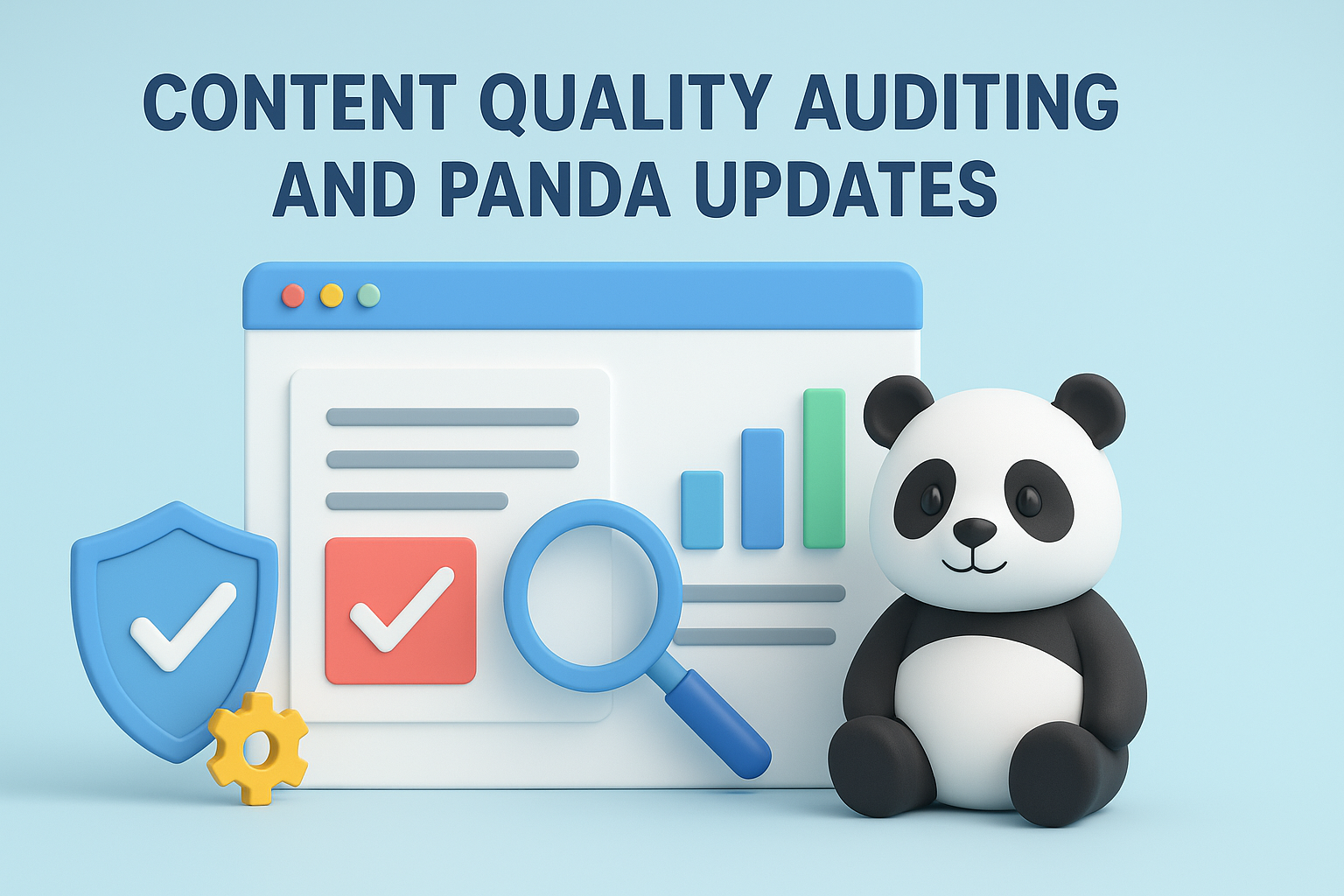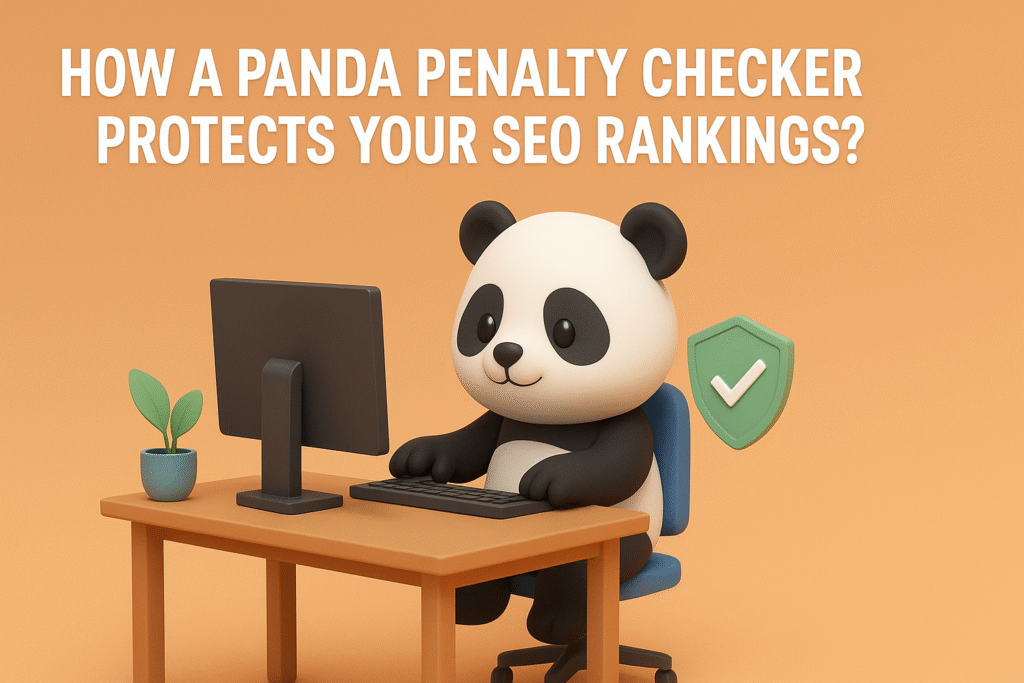If you’ve ever noticed a sudden drop in your website traffic, despite all your SEO efforts, you’re not alone. Many websites experience from unexpected ranking declines that are often linked to Google’s quality-focused algorithm updates — one of which is the Panda update.
Even though Google’s algorithm has evolved with hundreds of updates, Panda remains highly relevant because it targets what matters most — content quality. Websites with thin, duplicated, or low-value content still risk losing visibility in search results.
That’s where a panda penalty checker becomes a powerful ally. It helps you detect content-related issues early, allowing you to maintain rankings, protect visibility, and stay compliant with Google’s ever-demanding quality standards.
In this blog, we’ll explore how a panda penalty checker works, how it protects your SEO efforts, and why consistent content auditing is crucial for long-term search success.
Table of Contents
Understanding Google’s Panda Algorithm
When Google rolled out the Panda update in 2011, the goal was simple — improve the quality of search results by rewarding websites with valuable, user-focused content and demoting those with low-quality or spammy material.
Over time, Panda became part of Google’s core algorithm, meaning its impact is continuous rather than occasional.
Here’s what Panda primarily targets:
- Thin or low-value pages that don’t add real insights
- Duplicate or scraped content copied from other websites
- Excessive keyword stuffing or unnatural phrasing
- High ad-to-content ratio that disrupts user experience
- Poor engagement signals like low dwell time or high bounce rates
If your site fits any of these descriptions, you could unknowingly be affected by a Panda-related ranking drop — even without receiving a manual penalty.
Understanding this algorithm helps you see why regular audits using a panda penalty checker can make a real difference.
What Is a Panda Penalty Checker?
A panda penalty checker is a specialized tool that helps you analyze your website for potential content quality issues that could trigger a Panda-related ranking loss.
It scans your pages for:
- Duplicate or overlapping content
- Thin content with little to no value
- Over-optimized keyword usage
- Low user engagement signals
- Inconsistent quality or outdated information
In short, it’s a diagnostic tool that helps you identify weak spots before Google does. By fixing these areas early, you’re not only preventing a penalty — you’re improving your site’s overall SEO health.
Think of it as a content quality watchdog, constantly monitoring your pages to ensure they meet Google’s evolving expectations.
How Panda Penalty Checkers Work Behind the Scenes?
Most panda penalty checker tools use a combination of algorithms, data integrations, and AI analysis to evaluate content quality. Here’s a simple breakdown of how they typically work:
- Website Scan and Crawl:
The tool crawls your site just like search engines do, mapping out all pages and identifying potential issues. - Duplicate Content Detection:
It checks if any part of your content matches other pages on your site or across the web. - Thin Content Identification:
Pages with minimal text, poor readability, or little informational value are flagged for review. - Keyword Optimization Check:
It measures keyword density and contextual relevance to prevent overuse or keyword stuffing. - Engagement and Performance Metrics:
The tool may integrate with Google Analytics or Search Console to measure bounce rate, time-on-page, and traffic consistency. - Comprehensive Report Generation:
You receive a report highlighting all the risk areas — allowing you to take proactive steps before rankings drop.
In essence, a panda penalty checker acts as your ongoing SEO health monitor, protecting your rankings by keeping content in line with Google’s standards.
Top Signs Your Website May Have a Panda Penalty
You don’t always get a clear notification when Panda affects your website. However, certain patterns often signal that something’s wrong. Watch out for:
- Sudden Traffic Drop: Organic traffic falls significantly without a known reason.
- Poor User Metrics: High bounce rates and short session durations indicate low engagement.
- Decline in Rankings: Keywords that once performed well start losing visibility.
- Duplicate Pages: Multiple pages with similar or overlapping content exist on your site.
- Irrelevant or Low-Value Articles: Content that doesn’t address user intent or adds little depth.
If you notice these symptoms, it’s time to run a panda penalty checker and investigate what’s causing the decline.
Key Features to Look for in a Reliable Panda Penalty Checker
Not all tools are created equal. When choosing a panda penalty checker, focus on one that offers a comprehensive set of features such as:
- Content Quality Scoring: A numerical or color-coded score indicating how strong your content is.
- Duplicate Content Detection: Identifies similarities within your site and across the internet.
- Thin Content Alerts: Flags pages with insufficient word count or poor informational depth.
- Keyword Optimization Analysis: Ensures natural keyword placement and readability.
- User Behavior Integration: Connects engagement data to content performance.
- Mobile and Technical SEO Checks: Examines page speed, UX, and structure for indirect quality signals.
These features ensure that your site isn’t just technically optimized, but also aligned with Google’s focus on relevance, user intent, and originality.
How a Panda Penalty Checker Protects Your SEO Rankings?
Your content can look perfectly fine on the surface yet still be vulnerable to Panda’s scrutiny. A panda penalty checker protects your rankings by:
- Early Detection of Quality Issues
Instead of waiting for a ranking drop, the tool detects low-quality signals proactively. - Maintaining Google’s Trust
Regular audits demonstrate that your site follows best practices, strengthening your domain’s credibility. - Supporting E-E-A-T Compliance
Google’s ranking systems now emphasize Experience, Expertise, Authoritativeness, and Trustworthiness. Quality checks help you meet these standards consistently. - Preventing Algorithmic Demotions
By addressing thin or repetitive content early, you avoid being algorithmically suppressed. - Improving Overall SEO Health
A cleaner, more valuable site structure translates into better engagement and sustained visibility.
This proactive approach ensures you never wake up to a sudden drop in search performance.
Steps to Recover from a Panda Penalty Using a Checker Tool
If your website has already suffered a Panda-related penalty, recovery is absolutely possible. Here’s a step-by-step guide:
- Run a Full Content Audit
Use a panda penalty checker to identify which pages have low scores or duplicate content. - Categorize the Issues
Group problematic pages based on the type of issue — thin content, duplication, or poor engagement. - Revise or Remove Weak Pages
Improve low-quality pages with better information, updated data, and more depth. Remove redundant ones entirely. - Optimize for Relevance and Readability
Make sure each page aligns with search intent and flows naturally for readers. - Re-submit for Indexing
Once improvements are made, request re-indexing via Google Search Console. - Monitor Progress Regularly
Track rankings, impressions, and engagement metrics over the next few weeks to ensure recovery.
By following this structured recovery plan, you can regain your lost visibility and build a stronger SEO foundation.
Integrating Panda Penalty Checkers into Your SEO Workflow
The smartest SEO strategies are proactive, not reactive. Integrating a panda penalty checker into your workflow ensures ongoing quality assurance.
Here’s how:
- Schedule Routine Checks: Perform monthly or quarterly audits, especially after publishing new content.
- Automate Reports: Many tools let you receive automatic updates about emerging issues.
- Combine with Other Audits: Use alongside Penguin, Core Web Vitals, and manual checks for a 360° SEO view.
- Guide Content Planning: Use audit results to refine your content strategy, prioritizing topics that add real value.
This integration transforms your SEO approach from guesswork to data-backed decision-making — and that’s what keeps rankings stable.
Common Mistakes to Avoid When Using a Panda Penalty Checker
Even with the right tools, certain mistakes can undermine your efforts. Avoid these pitfalls:
- Ignoring Minor Warnings: Small issues can pile up over time and lead to significant ranking drops.
- Focusing on Word Count Over Value: Long content isn’t always quality content — relevance matters more.
- Over-Optimization: Avoid cramming keywords or making content sound unnatural after cleanup.
- Neglecting UX: Even great content suffers if your site layout or navigation frustrates users.
- Not Tracking Changes: Always document what’s been fixed and monitor the results closely.
Consistency and attention to detail make the biggest difference in SEO longevity.
Content Quality Auditing and Panda Updates

As Google integrates more AI into its algorithms, the standards for content quality will continue to rise.
Future Panda-like updates are expected to assess not just what you write, but how well your content satisfies user intent and demonstrates expertise.
This means:
- Tools like the panda penalty checker will evolve with AI-driven analysis for better accuracy.
- Websites will need ongoing audits, not occasional ones.
- Authentic, user-first content will always outperform keyword-heavy, low-quality material.
In short, the future belongs to those who treat SEO as an ongoing quality improvement process, not a one-time checklist.
Conclusion
Google’s Panda update continues to remind us that content quality is the foundation of SEO. Whether you’re a business owner, blogger, or digital marketer, maintaining high standards of content is no longer optional.
A panda penalty checker empowers you to detect weak points, refine your site’s value, and stay ahead of algorithmic changes. By integrating it into your regular SEO workflow, you ensure that your site remains trustworthy, relevant, and resilient — no matter how Google evolves.
The key is simple: don’t wait for penalties to strike. Audit early, act fast, and keep improving. That’s how you protect your rankings and build lasting visibility in search.
FAQs
Q1. What is a panda penalty checker?
A panda penalty checker is a tool that helps identify content issues like thin, duplicate, or low-quality pages that may trigger Google’s Panda-related ranking drops.
Q2. How do I know if my website is hit by a Panda penalty?
Look for sudden organic traffic drops, lower engagement, or ranking declines without a manual penalty notice.
Q3. Can a panda penalty checker help me recover lost rankings?
Yes, it helps pinpoint problem areas so you can improve or remove low-quality pages and restore your rankings over time.
Q4. How often should I check my site for Panda-related issues?
It’s best to run audits quarterly or after publishing large amounts of new content.
Q5. Is Panda still relevant after Google’s core updates?
Absolutely. Panda’s principles around content quality remain part of Google’s core algorithm, so maintaining quality remains essential.



